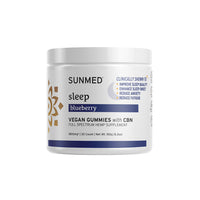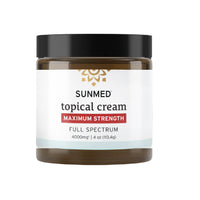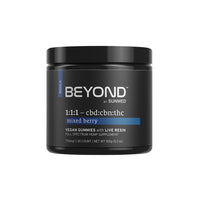Do Edibles Expire? Factors that Affect Shelf Life
Find out if edibles are safe to eat after their expiration date and explore tips to extend your edible’s shelf life with Sunmed.

Have you ever found an old package of CBD gummies or infused chocolate and wondered if it’s still good? It’s a common question, and the answer depends on more than just the expiration date on the package.
Like any food product, edibles — whether infused with hemp extract, CBD, or other ingredients — have a shelf life. However, what happens to an edible over time depends on how it’s stored, what it’s made from, and how it’s packaged.
An edible past its prime isn’t necessarily unsafe to consume, but its texture, flavor, and cannabinoid content can change over time. While some edibles contain preservatives that extend their shelf life, others (especially those made with natural ingredients) may spoil sooner.
Understanding what affects shelf life can help you store your products properly and get the most out of them.
Whether you have gummies, chocolates, baked goods, or tincture-based edibles, knowing how and when they degrade can help you make informed choices about freshness and potency.
Do edibles expire?
Expiration means a product has reached the end of its safe or optimal quality. In the case of edibles, this can mean changes in texture, flavor, and freshness.
While some ingredients, such as certain dairy products, may become unsafe after expiring, other ingredients (like cannabinoids) may lose their potency and become less effective without being harmful.*
The shelf life of an edible, or how long it stays good, depends on the type of product. Gummies and hard candies typically last the longest, often a year or more, because they contain little moisture. Chocolates have a similar shelf life but can develop a white coating called “chocolate bloom” when exposed to temperature changes.
Baked goods and perishable items have a much shorter lifespan, sometimes only weeks, unless refrigerated or frozen.
CBD-infused edibles don’t necessarily spoil faster than their non-infused versions, but the cannabinoids inside them can degrade with exposure to heat, light, and air.* Over time, this can reduce potency, meaning the edible may not have the same effects as when it was fresh. Proper storage helps maintain both quality and effectiveness.
What to know about cannabinoid stability over time
Cannabinoids, including CBD and THC, are sensitive to environmental factors.* Over time, exposure to oxygen, heat, and light can cause degradation, which means a product may not be as effective as when it was fresh.*
When used correctly, cannabinoids like CBD are revered for their potential to work with the body’s endocannabinoid system to help ease discomfort, support healthy sleep habits, calm the mind, and soothe stress and tension.*
While the loss of potency in an edible doesn’t make it unsafe to eat, it does mean the cannabinoids may not provide the same wellness benefits.* Proper storage helps slow this process and preserves the effectiveness of infused products for as long as possible.
What factors affect the shelf life of edibles?
When it comes to how long your edibles can last, there are a few factors to consider.
Ingredients
What an edible is made from significantly affects how long it stays fresh. Products containing dairy, eggs, or other perishable ingredients spoil faster, especially if left at room temperature. This is why baked goods, infused yogurts, and similar products need refrigeration.
Dry edibles like gummies, hard candies, and chocolates generally last longer because they contain less moisture, reducing the chance of bacterial growth. However, natural ingredients, including fruit extracts and plant-based colorants, can break down over time, altering the taste and texture.
While preservatives can extend shelf life, many wellness-focused hemp-infused edibles avoid artificial additives, so they may expire sooner than conventional packaged snacks.*
Packaging and sealing
An edible’s packaging makes a big difference in how well it retains freshness. Air-tight, resealable packaging helps prevent exposure to oxygen, which can degrade cannabinoids and affect texture. Products sealed in mylar bags, glass jars, or vacuum-sealed pouches last longer than those stored in paper or open containers.
Once a package is opened, air, humidity, and contaminants can speed up spoilage. Keeping edibles in their original packaging or transferring them to a sealed container can help maintain quality for longer.
Storage conditions
Temperature, light, and moisture all impact shelf life. It’s ideal to store edibles in a cool, dark, and dry place. Heat and direct sunlight can break down cannabinoids and cause chocolates or gummies to melt, altering texture and potency.
Refrigeration is recommended for perishable edibles and can extend the shelf life of many hemp-infused products. However, storing them properly is important — excess moisture from the fridge can lead to mold growth in improperly sealed containers. Freezing is another option for long-term storage, especially for baked goods, but it may affect texture once thawed.
How to tell if an edible has expired
Before eating an edible, it’s important to check for signs that it may have expired. While some products lose potency over time, others may develop visible spoilage, making them unsafe to consume.
Check the expiration date
Most edibles have a “best by” or expiration date printed on the packaging. This date indicates how long the product is expected to stay fresh when stored properly. While an edible past its best-by date may not be harmful, it may have lost its intended flavor, texture, or cannabinoid content.
Look for changes in appearance
Spoiled edibles often show visible signs of degradation. Mold growth — appearing as fuzzy white, green, or black spots — clearly indicates that the product is no longer safe to eat. Discoloration or an unusual dullness in color can also suggest that the product has started to break down.
Smell and taste test
If an edible smells rancid, sour, or otherwise off, it’s best to discard it. Fats and oils in chocolates or baked goods can turn rancid over time, giving them an unpleasant odor or taste. A change in flavor that seems stale or overly bitter may indicate that the product is no longer fresh.
Texture changes
Changes in texture can also be a sign that an edible is past its prime. Gummies that have become overly hard, sticky, or grainy have likely degraded. Chocolates may develop a chalky or powdery texture due to fat separation, while baked goods may dry out or crumble excessively.
How to extend the shelf life of edibles
A few simple steps can help keep edibles fresh for as long as possible. Proper storage, temperature control, and handling all play a role in preserving quality.
Store properly
Keeping edibles in a cool, dry place is one of the best ways to extend their shelf life. Since heat and humidity can cause spoilage, it’s best to store products in a pantry, cupboard, or other dark areas away from direct sunlight.
Resealable containers or vacuum-sealed bags help prevent air exposure, which can accelerate oxidation and degrade cannabinoids. Glass jars and mylar bags are also good options for preserving freshness.
Refrigeration and freezing
Refrigeration is recommended for edibles that contain dairy, eggs, or other perishable ingredients to prevent spoilage and extend freshness. Chocolates and gummies can also be stored in the refrigerator if temperatures are consistently warm in your home.
Freezing is an option for long-term storage, particularly for baked goods. If freezing, wrap items in airtight packaging to prevent freezer burn. When thawing, allow the edible to reach room temperature gradually to maintain texture and taste.
Avoid cross-contamination
Using clean hands or utensils when handling edibles helps prevent bacteria or moisture from entering the packaging. For items like gummies or chocolates, resealing the bag after each use is important to maintain freshness.
Moisture exposure can lead to mold growth, particularly for baked goods. Keep edible storage areas dry and avoid placing products in humid environments, such as near the stove or dishwasher.
What happens if you eat an expired edible?
If an edible is simply past its best-by date but shows no signs of spoilage, it may still be safe to eat. However, the texture, flavor, and cannabinoid content may not be the same as when it was fresh. The cannabinoids inside may have degraded, which could result in a weaker or less noticeable effect.*
Eating a spoiled edible, on the other hand, can pose a risk. Moldy or rancid food can cause digestive discomfort or illness. If an edible smells off, looks discolored, or has a strange texture, it’s best to throw it away.
Checking for spoilage before consumption is the easiest way to avoid any issues. Proper storage reduces the risk of edibles going bad too soon and helps ensure that the cannabinoids inside remain as effective as possible.
The bottom line
Edibles do expire, but how quickly they degrade depends on their ingredients, packaging, and storage conditions.
Gummies, chocolates, and hard candies typically last longer than baked goods or perishable items. While cannabinoids inside an edible may lose potency over time, proper storage helps preserve effectiveness.
Keeping edibles in airtight containers, storing them in a cool, dark place, and avoiding moisture exposure are simple ways to extend shelf life. When in doubt, check for signs of spoilage before consuming. A little extra care in handling and storage can help ensure your edibles stay fresh and effective for as long as possible.
*This statement has not been evaluated by the Food & Drug Administration. This product is not intended to diagnose, treat, cure, or prevent any disease.
Sources:
Shelf Life - an overview | ScienceDirect Topics
The endocannabinoid system: Essential and mysterious | Harvard Health










